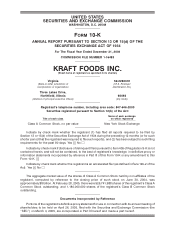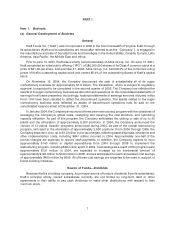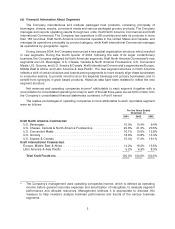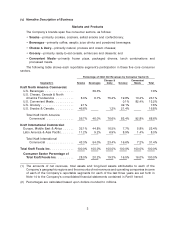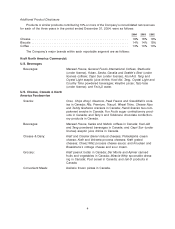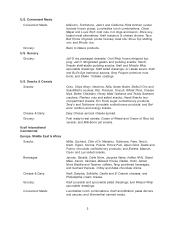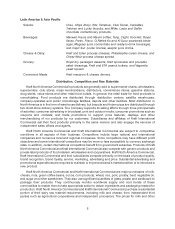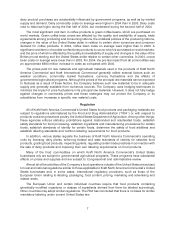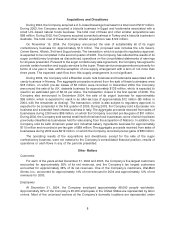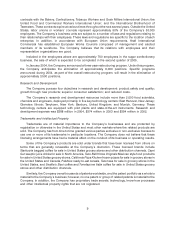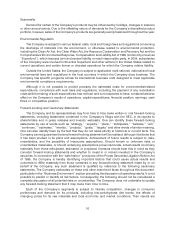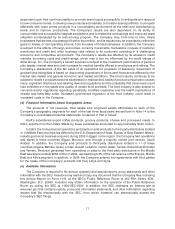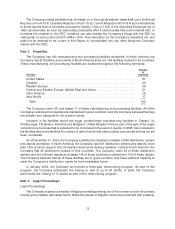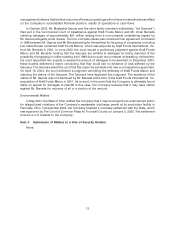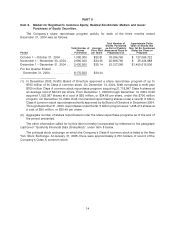Kraft 2004 Annual Report Download - page 8
Download and view the complete annual report
Please find page 8 of the 2004 Kraft annual report below. You can navigate through the pages in the report by either clicking on the pages listed below, or by using the keyword search tool below to find specific information within the annual report.dairy product purchases are substantially influenced by government programs, as well as by market
supply and demand. Dairy commodity costs on average were higher in 2004 than in 2003. Dairy costs
rose to historical highs during the first half of 2004, but moderated during the second half of 2004.
The most significant cost item in coffee products is green coffee beans, which are purchased on
world markets. Green coffee bean prices are affected by the quality and availability of supply, trade
agreements among producing and consuming nations, the unilateral policies of the producing nations,
changes in the value of the United States dollar in relation to certain other currencies and consumer
demand for coffee products. In 2004, coffee bean costs on average were higher than in 2003. A
significant cost item in chocolate confectionery products is cocoa, which is purchased on world markets,
and the price of which is affected by the quality and availability of supply and changes in the value of the
British pound sterling and the United States dollar relative to certain other currencies. In 2004, cocoa
bean costs on average were lower than in 2003. For 2004, the pre-tax impact from all commodities was
an approximate $930 million increase in costs as compared with 2003.
The prices paid for raw materials and agricultural materials used in the products of Kraft North
America Commercial and Kraft International Commercial generally reflect external factors such as
weather conditions, commodity market fluctuations, currency fluctuations and the effects of
governmental agricultural programs. Although the prices of the principal raw materials can be expected
to fluctuate as a result of these factors, the Company believes such raw materials to be in adequate
supply and generally available from numerous sources. The Company uses hedging techniques to
minimize the impact of price fluctuations in its principal raw materials. However, it does not fully hedge
against changes in commodity prices and these strategies may not protect the Company or its
subsidiaries from increases in specific raw material costs.
Regulation
All of Kraft North America Commercial’s United States food products and packaging materials are
subject to regulations administered by the Food and Drug Administration (‘‘FDA’’) or, with respect to
products containing meat and poultry, the United States Department of Agriculture. Among other things,
these agencies enforce statutory prohibitions against misbranded and adulterated foods, establish
safety standards for food processing, establish ingredients and manufacturing procedures for certain
foods, establish standards of identity for certain foods, determine the safety of food additives and
establish labeling standards and nutrition labeling requirements for food products.
In addition, various states regulate the business of Kraft North America Commercial’s operating
units by licensing dairy plants, enforcing federal and state standards of identity for selected food
products, grading food products, inspecting plants, regulating certain trade practices in connection with
the sale of dairy products and imposing their own labeling requirements on food products.
Many of the food commodities on which Kraft North America Commercial’s United States
businesses rely are subject to governmental agricultural programs. These programs have substantial
effects on prices and supplies and are subject to Congressional and administrative review.
Almost all of the activities of the Company’s food operations outside of the United States are subject
to local and national regulations similar to those applicable to Kraft North America Commercial’s United
States businesses and, in some cases, international regulatory provisions, such as those of the
European Union relating to labeling, packaging, food content, pricing, marketing and advertising and
related areas.
The European Union and certain individual countries require that food products containing
genetically modified organisms or classes of ingredients derived from them be labeled accordingly.
Other countries may adopt similar regulations. The FDA has concluded that there is no basis for similar
mandatory labeling under current United States law.
7

